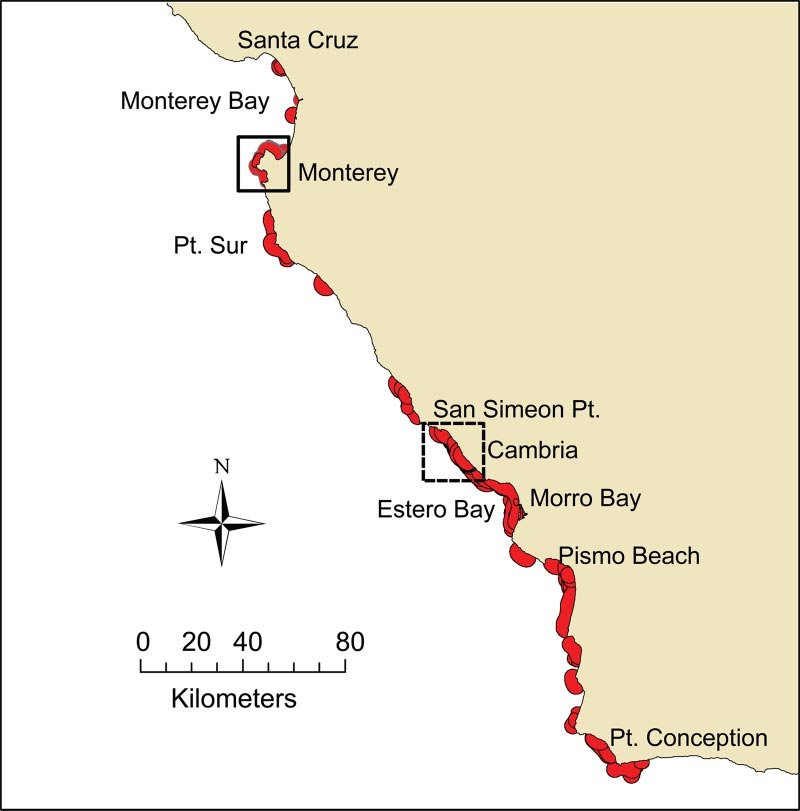Population Status
Researchers estimated 150,000 to 300,000 sea otters once occurred in a connected population from northern Japan to Baja, Mexico. Due to the escalating value of sea otter furs in the 19th Century, and their vulnerability to maritime trappers and hunters, sea otter populations declined by approximately 99%.
In Oregon, the majority of the population was lost to fur hunters by the mid 1850’s and were extinct by the early 20th Century.
Although still missing from Oregon, sea otters populations now found in parts of coastal California, Washington, British Columbia, southeast Alaska and many islands in the Aleutian Island archipelago.
With no otters in Oregon, there is a gap of more than 840 miles between sea otters in California and those in Washington.

California
CALIFORNIA is home to about 3,000 southern sea otters, which are a smaller subspecies that is smaller than those further north. These sea otters are descended from a remnant group that escaped fur hunters and survived in an isolated area off the Big Sur coast.
The population is confined to about 13% of its historic range, from just north of Santa Cruz to just south of Point Conception. A subpopulation lives around San Nicolas Island in the Channel Islands.
Sea otters are found primarily on the open coast, but a significant number of animals live in Elkhorn Slough, an estuary fronting Monterey Bay between Monterey and Santa Cruz. This includes many sea otters who were found as abandoned pups and reared in a foster-mother environment at the Monterey Bay Aquarium before being released into Elkhorn Slough. The presence of sea otters within the Elkhorn Slough estuary has resulted in ecological impacts that have helped the estuary to recover from effects of pollution entering from agricultural and urban areas in the watershed.
Overall numbers seem to be increasing slowly, with 3,104 animals counted in the 2017 survey. However, localized declines at the northern and southern ends of the range and inability of the population to expand to the north, continue to cause concern. Predation by Great White sharks appears to be one factor in preventing sea otters from migrating north of their present range.


Washington
WASHINGTON has a population of northern sea otters, a larger subspecies. Today’s animals descend from 59 animals that were relocated from the Aleutian Islands in 1969 and 1970 to two sites on the Olympic coast. The 2017 census counted 2,058 animals, the highest recorded, still confined to the Olympic coast. A few wandering male sea otters are occasionally seen in Puget Sound, the San Juan Islands, and along the Oregon coast at places such as Depoe Bay, Yaquina Head, and Cape Arago.
British Columbia
BRITISH COLUMBIA also has a growing population of northern sea otters. As in other areas of the Pacific coast, sea otters were hunted to extinction by the maritime fur trade. In 1969, 1970, and 1971, a total of 89 animals from the Aleutian Islands were reintroduced to two sites on the west coast of Vancouver Island. The population has steadily increased, spreading along the west coast of Vancouver Island, and small areas of the mainland.

Alaska
From 1741 to the mid 1800’s sea otters in Alaska were hunted extensively by Russian fur trappers/hunters, and were nearly extinct by 1867.
In the late 1960’s, 450 sea otters were reintroduced to SE Alaska from Aleutian Islands, and the population has grown above 25,000 due the high carrying capacity of this region. While SE Alaska populations remain robust, concern has grown over declines in populations throughout the Aleutian Island chain and research suggest this predation pressure by killer whales may be connected to population declines in other whale species that were a significant prey resource for northern killer whales.


